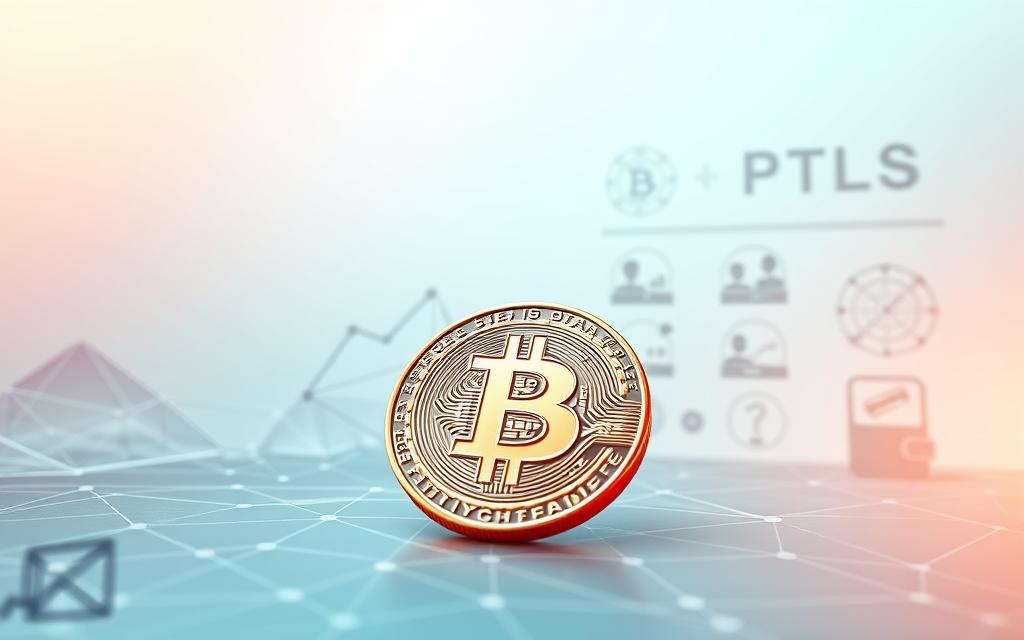Table of Contents
Digital money has changed how people think about payments. Unlike traditional cash, it operates without banks or governments. Blockchain technology powers this system, ensuring secure and transparent transactions.
Bitcoin, launched in 2009, remains the most well-known example. Its value has reached over $65,000, showing real-world impact. Other coins now exist, each with unique features.
New users often struggle with technical terms and security concerns. This guide breaks down complex ideas into simple concepts. Learn how decentralized networks verify transactions safely.
The world of digital assets keeps evolving. Start with the fundamentals before exploring deeper topics. Build confidence step by step.
What Is Cryptocurrency? A Simple Definition
Imagine money that exists purely online, secured by advanced math instead of physical banks. That’s the core idea behind cryptocurrency—a digital asset designed for secure peer-to-peer transactions without intermediaries.
Digital Currency vs. Traditional Money
Unlike dollar bills you can hold, crypto exists as code on a blockchain ledger. Traditional money relies on banks to verify payments. Digital currency uses decentralized networks where users collectively validate transactions.
The Federal Reserve controls USD supply, but Bitcoin’s 21 million coin cap makes it inflation-resistant. This difference highlights why some view crypto as “programmable money” with built-in economic rules.
Decentralization: No Central Authority
When Visa processes payments, it acts as a single control point. Bitcoin’s network distributes power across thousands of nodes globally. This structure prevents system failures if one node goes offline—unlike bank outages that freeze accounts.
The 2008 financial crisis directly inspired Bitcoin’s creation. Its whitepaper proposed an alternative to centralized institutions that had failed consumers. Today, this philosophy remains central to most digital currencies.
“A purely peer-to-peer version of electronic cash would allow online payments to be sent directly without relying on financial institutions.”
Decentralization also enhances security. Hackers can’t target one central database because copies of the ledger exist across the entire network. Each new transaction gets verified by multiple participants.
How Cryptocurrency Works: Blockchain Basics
Blockchain acts like a digital ledger, recording every transaction securely. Unlike a bank checkbook, it’s more like a shared Google Sheet—visible to all participants but impossible to alter retroactively. This system ensures trust without intermediaries.

The Role of Mining in Creating Coins
Specialized hardware like Antminer S19 solves complex math problems to validate transactions. This process, called mining, rewards participants with new coins. Bitcoin’s network consumes 147.7 TWh yearly—more than Ukraine’s entire energy usage.
Traditional payment networks like Mastercard use far less power. However, crypto advocates argue the energy secures a decentralized ledger. Each block holds ~2,400 transactions, locked permanently after verification.
Public Ledgers and Transaction Verification
Every transaction appears on the blockchain, visible but anonymized. Exchanges like Coinbase confirm payments in 10–60 minutes. Unlike banks, no single entity controls the ledger; thousands of nodes cross-check data.
Ethereum expands this concept with smart contracts—self-executing agreements stored on its blockchain. This shows the technology’s versatility beyond Bitcoin’s transactions.
“Mining decentralizes trust, replacing institutions with cryptographic proof.”
Understanding these system basics demystifies how value moves digitally. For deeper insights, explore blockchain mechanics or wallet security next.
How to Explain Cryptocurrency in Everyday Terms
Think of Bitcoin as digital gold—rare, valuable, and immune to inflation. Just like gold’s limited supply, Bitcoin’s 21 million cap ensures scarcity. This makes both assets resistant to devaluation over time.
Comparing Crypto to Familiar Concepts
Digital gold isn’t just a catchy phrase. Bitcoin’s “halving” events reduce new coin supply, mirroring gold mining’s increasing difficulty. Both systems rely on scarcity to preserve value.
| Concept | Traditional | Crypto |
|---|---|---|
| Ledger | Bank-controlled | Community spreadsheet |
| Supply Control | Federal Reserve | Algorithmic halving |
| Transaction Fees | Flat rates | Network tolls (gas fees) |
“Bitcoin’s fixed supply mimics precious metals, creating a hedge against inflation.”
Demystifying Technical Jargon
Technical jargon trips up 61% of Americans. Replace “decentralized ledger” with “shared Google Sheet.” Imagine Ethereum’s gas fees as highway tolls—pay more during rush hour (network congestion).
Common terms simplified:
- HODL: Holding coins long-term, despite market swings.
- Whale: Someone with enough crypto to sway prices.
- Smart contract: Vending machine logic—automated, transparent deals.
Wallet transactions work like PayPal, but without bank delays. The technology isn’t magic—just a new way to move value peer-to-peer.
Major Cryptocurrencies and Their Uses
The digital asset landscape features diverse currencies, each serving unique purposes. While Bitcoin dominates market value, alternatives like Ethereum and Litecoin address specific needs. Understanding their differences helps users navigate this evolving space.

Bitcoin: The Pioneer
Launched in 2009, Bitcoin remains the flagship digital currency with a $1.2 trillion market cap. Its proof-of-work system prioritizes security over speed, settling transactions in 10 minutes. Investors often treat it as a store of value, similar to gold.
Ethereum, Litecoin, and Altcoins
Ethereum processes 1.2 million daily transactions—triple Bitcoin’s volume—powering decentralized apps (dApps). Platforms like Uniswap and Aave enable peer-to-peer trading, bypassing traditional banks.
Litecoin offers faster 2.5-minute block times, positioning itself as “silver” to Bitcoin’s “gold.” Its lower fees suit small transactions, though it lacks Ethereum’s smart contract flexibility.
Niche altcoins serve specialized applications:
- Chainlink: Connects blockchains to real-world data (oracles).
- Filecoin: Decentralized cloud storage alternative.
- BAT: Rewards users for ad engagement in browsers.
“Meme coins like Dogecoin surged 12,000% in 2021 but crashed months later—speculative assets carry high risk.”
While innovation thrives, research is crucial. Not all currencies offer equal utility or stability.
How to Buy Cryptocurrency Safely
Entering the world of digital assets requires secure purchasing methods. Platforms vary in features, fees, and security measures. Understanding these differences helps avoid costly mistakes.

Choosing a Platform: Exchanges vs. Brokers
Exchanges like Binance offer advanced trading tools but have steeper learning curves. Brokers such as Robinhood simplify purchases with intuitive interfaces. Coinbase balances both, ideal for beginners.
Key differences:
- FDIC insurance: Kraken and Gemini protect USD balances up to $250,000.
- Fees: Coinbase charges 0.50% spread + 1% per transaction. Robinhood offers zero-fee trades but limits coin transfers.
- Security: 78% of hacks target centralized exchanges—verify platform audits.
Payment Methods and Fees
Credit cards often trigger cash advance fees (up to 5%). Bank transfers (ACH) are cheaper but slower than wire transfers. Always compare payment methods before funding your account.
Red flags to avoid:
- Missing two-factor authentication (2FA).
- Platforms storing funds in hot wallets only.
- Fake app stores mimicking legitimate services.
“Centralized exchanges dominate trading volume but require rigorous security checks.”
Storing Cryptocurrency: Wallets Explained
Protecting digital assets requires the right tools and knowledge. Unlike bank accounts, crypto wallets give users full control—and responsibility. Choosing the wrong storage method increases risk.
Hot Wallets vs. Cold Wallets
Hot wallets like MetaMask connect to the internet for easy access. In 2020, hackers stole $15M from MetaMask users due to phishing attacks. Convenience comes with vulnerabilities.
Cold wallets, such as Trezor or Ledger Nano X, store assets offline. The Ledger Nano X supports 1,800+ coins and blocks remote attacks. Ideal for long-term holders.
| Feature | Hot Wallets | Cold Wallets |
|---|---|---|
| Internet Access | Always online | Offline storage |
| Security Level | Moderate | High |
| Best For | Daily transactions | Large holdings |
Security Best Practices
A German programmer recovered $650M in Bitcoin using his seed phrase—a 12–24-word backup. Lose it, and funds vanish forever.
Essential precautions:
- Multi-signature setups: Require 2+ approvals for transactions over $10K.
- Phishing tests: Verify sender emails and URLs before clicking.
- Firmware updates: Patch vulnerabilities in hardware wallets monthly.
“Cold storage reduces attack surfaces by 90% compared to hot wallets.”
Step-by-step Ledger setup:
- Download Ledger Live from the official site.
- Write the seed phrase on paper (never digitally).
- Enable PIN and 2FA for transfers.
What Can You Buy with Cryptocurrency?
From coffee to luxury watches, digital currencies now power real-world transactions. Over 15,000 businesses globally accept Bitcoin, according to 2024 BitPay data. This growing market spans essential services and high-end indulgences.

Everyday Purchases and Luxury Goods
Major brands now integrate crypto payments into their systems. AT&T accepts Bitcoin for phone bills, while Microsoft Azure allows blockchain subscriptions. These everyday purchases demonstrate practical adoption.
For luxury goods, BitDials sells Rolex watches exclusively for Bitcoin. Their inventory includes rare Patek Philippe models valued at over 15 BTC. High-end adoption extends to:
- Overstock: Furniture and home goods
- Miami Dolphins: NFL game tickets
- Prestige Cruises: Yacht charters
| Category | Vendor | Payment Options |
|---|---|---|
| Tech | Newegg | BTC, ETH, LTC |
| Travel | CheapAir | BTC only |
| Gaming | Xbox Store | BTC via BitPay |
“Merchant adoption grew 174% last year, with luxury sectors leading the trend.”
Limitations and Adoption Challenges
Tesla’s reversal on $1.5B Bitcoin car payments highlights volatility concerns. Many businesses still hesitate due to:
- Price fluctuations during settlement
- Regulatory uncertainty in some regions
- Tax reporting complexities
El Salvador’s Chivo wallet faced technical issues despite government backing. Starbucks’ closed-loop blockchain trials also stalled due to slow transaction speeds. These limitations show infrastructure gaps.
Important note: The IRS treats crypto purchases as taxable events. Selling digital assets to buy goods may trigger capital gains taxes—consult a tax professional.
Common Cryptocurrency Scams and How to Avoid Them
Fraudsters constantly evolve tactics to exploit digital asset investors. The FTC reported over $1 billion in crypto scam losses last year alone. Awareness of these scams helps users spot dangers before transferring funds.
Fake Websites and Ponzi Schemes
The BitClub Network Ponzi scheme stole $722 million by promising unrealistic mining profits. Such operations use new investors‘ money to pay earlier participants—until the whole system collapses.
Watch for these fake website tactics:
- Domain tricks: Scammers mimic real exchanges (e.g., Coinbase.pro instead of coinbase.com)
- Giveaway scams: Fake Elon Musk tweets demand “verification payments”
- Pig butchering: Romance scams slowly extract larger crypto deposits
Recognizing Red Flags
Legitimate projects always provide verifiable information. Check these security markers before investing:
- Registered team members with LinkedIn profiles
- Physical office addresses (Google Street View verified)
- SEC EDGAR database filings for U.S. projects
“No legitimate business asks for crypto payments to claim prizes—those are always scams.”
Wallet verification reduces risk. Always test small transactions first. Enable two-factor authentication on all exchange accounts.
Is Cryptocurrency a Safe Investment?
Digital assets present unique opportunities and challenges for investors. While potential rewards exist, understanding the risks is crucial before allocating funds. This section examines key factors affecting crypto’s safety as an investment.
Volatility and Market Risks
Bitcoin’s price swings average 4.2% daily—four times the S&P 500’s 1.1% fluctuation. Such volatility can create rapid gains but also steep losses. In 2022, the crypto market lost 70% of its value, demonstrating extreme market risks.
Traditional assets rarely experience these dramatic shifts. Gold, for example, hasn’t dropped more than 15% annually since 2013. Crypto’s unpredictability stems from:
- Speculative trading: 72% of retail traders lack formal investment education
- Market concentration: Bitcoin and Ethereum dominate 60% of total value
- Liquidity gaps: Small-cap coins face sudden price crashes
“Cryptocurrencies behave more like tech stocks than currency hedges during crises.”
Regulatory and Security Concerns
The SEC’s 2023 lawsuit against Coinbase highlighted growing regulatory concerns. Authorities worldwide are scrutinizing staking services under the Howey Test framework. Non-compliant platforms risk shutdowns or fines.
Security breaches remain a persistent threat. The FTX collapse involved $8 billion in missing customer funds—a stark reminder of custodial risks. Centralized exchanges face three main vulnerabilities:
- Insufficient reserve audits
- Poor private key management
- Inadequate insurance coverage
For beginners, experts recommend limiting crypto exposure to 5% of total assets. Diversification across established coins reduces concentration risk. Cold wallets provide safer storage than exchange accounts.
Explore crypto investment strategies for balanced portfolio approaches. Always verify platform security features before depositing funds.
Conclusion: Key Takeaways for Beginners
Mastering digital assets starts with understanding core principles. The blockchain ledger ensures transparency, while secure wallets protect your holdings. Always prioritize safety over convenience.
For beginners, research is non-negotiable. Verify sources before committing funds. A starter portfolio of 50% Bitcoin, 30% Ethereum, and 20% stablecoins balances growth and stability.
Leverage free courses on Coinbase Earn or Binance Academy. Avoid FOMO-driven investment in untested altcoins. Cryptocurrency rewards patience and informed decisions.
Remember: Every expert was once a newcomer. Build knowledge step by step, and let the key takeaways guide your journey.
FAQ
What makes cryptocurrency different from traditional money?
Unlike fiat currencies controlled by banks, digital currencies operate on decentralized networks. Transactions are verified by users, not a central authority, ensuring transparency.
How does blockchain technology secure transactions?
Blockchain acts as a public ledger, recording every transaction across a network. Mining validates new entries, making fraud nearly impossible without altering the entire chain.
Which platforms are best for buying Bitcoin or Ethereum?
Popular exchanges like Coinbase and Binance offer secure purchases. Compare fees, payment methods, and security features before choosing.
Are hot wallets riskier than cold storage?
Hot wallets connect to the internet, posing higher hacking risks. Cold wallets (like Ledger or Trezor) store assets offline, ideal for long-term holdings.
Can crypto replace everyday payments?
Some retailers accept Bitcoin or altcoins, but adoption remains limited. Volatility and regulatory hurdles slow mainstream use for daily transactions.
What’s the biggest threat to crypto investors?
Scams like fake exchanges or phishing attacks target users. Always verify URLs, enable two-factor authentication, and avoid “too good to be true” schemes.
Why does Bitcoin’s value fluctuate so much?
Limited supply and speculative trading drive volatility. News, regulations, and institutional investments heavily impact market prices.









